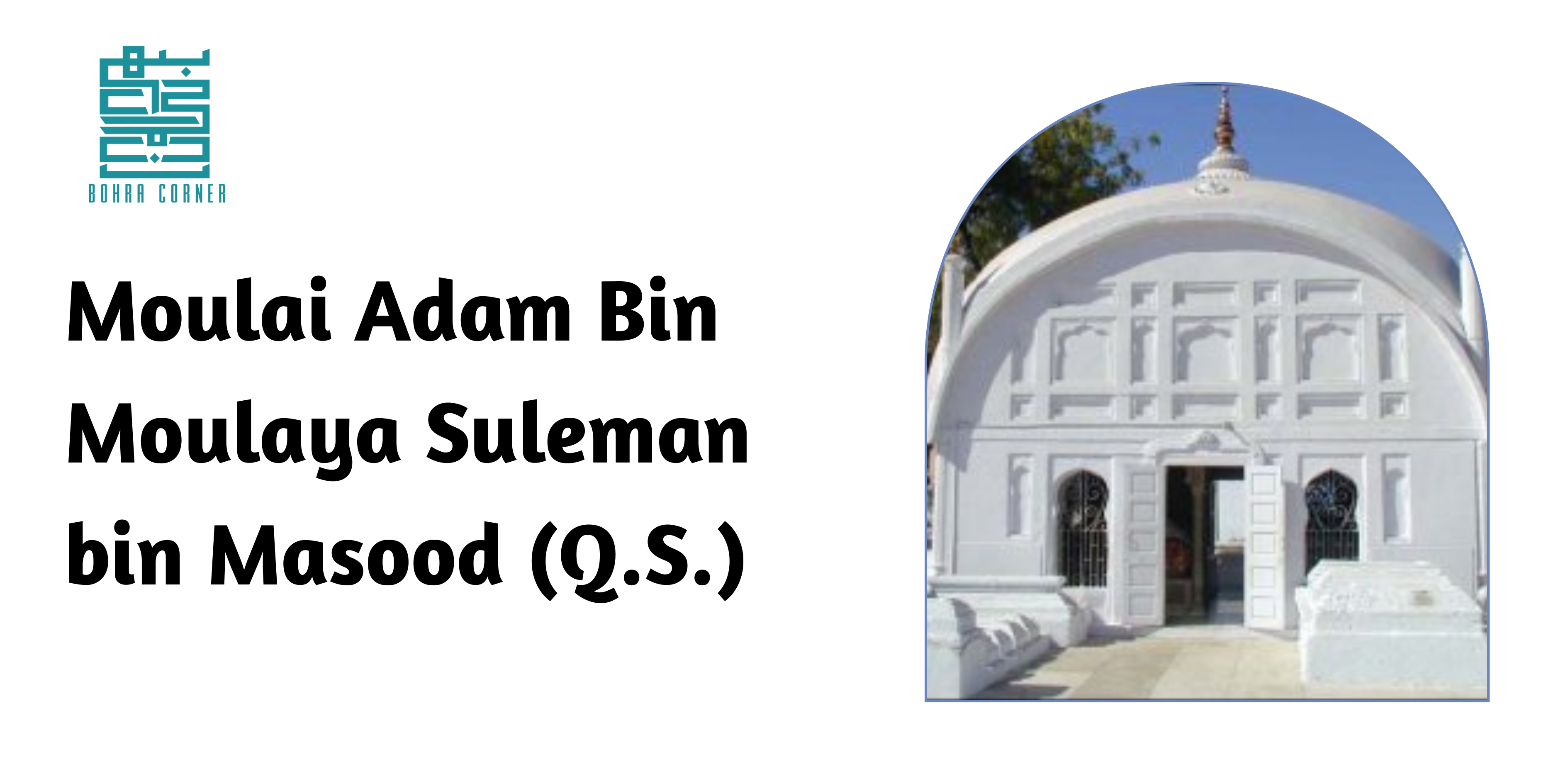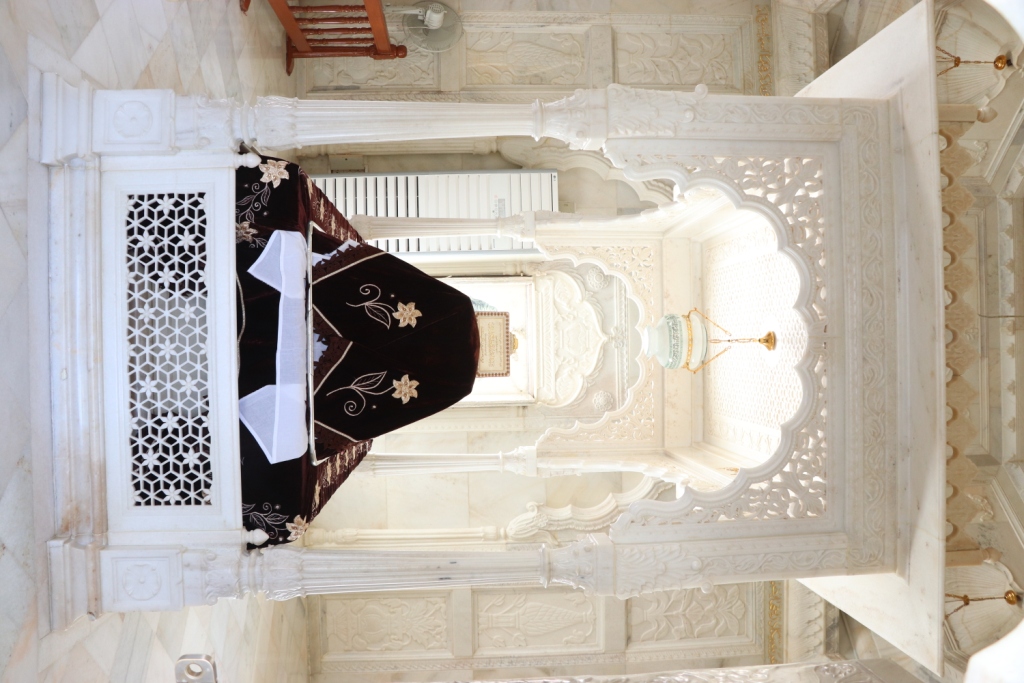Moulai Adam Bin Moulaya Suleman bin Masood (Q.S.)
Wafat : 13th Safar-Ul-Muzaffar 836 AH

The history of the Dawoodi Bohra community is rich with tales of devout leaders and spiritual figures who guided the faithful through periods of prosperity and challenge. Among these revered personalities is Moulai Adam Bin Moulaya Suleman bin Masood (Q.S.), an exemplary Vaali-ul-Hind whose life and unwavering faith left a lasting impact on the community in India. His story is a testament to the strength of belief, integrity, and the deep-seated respect for the authority of the Dai al-Mutlaq. This blog post explores the life, contributions, and profound legacy of this remarkable spiritual leader.
A Vaali of Great Stature and Integrity
Moulai Adam (Q.S.), also known as Moulai Adam Shujauddin (Q.S.), succeeded Syedi Hasanfeer Shaheed (Q.S.) as the Vaali-ul-Hind. He hailed from Neharwala, a town in the Patan region of Gujarat, India. It was in Patan that he received his spiritual education, or ‘Ilm’, under the tutelage of another great figure, Maulai Ali bin Maulai Ishaq (Q.S.). This early foundation in religious knowledge and spiritual discipline prepared him for the significant responsibilities he would later undertake.
His time as Vaali-ul-Hind coincided with a pivotal moment in the history of Gujarat. In 810 AH, Sultan Ahmed Shah founded the city of Ahmedabad and sought to invite the Bohra community to settle there. He extended an ‘Araz’ (an invitation) to Maulai Ali (Q.S.), recognizing the Bohras’ reputation for honesty and hard work. In response, Maulai Ali (Q.S.) entrusted the important task to Moulai Adam (Q.S.), along with Maulai Khwaja Kalan (Q.S.) and Shaikh Mujaal (Q.S.). This move marked the beginning of a new chapter for the Bohra community in Ahmedabad, with Moulai Adam (Q.S.) appointed as the Vaali of the city.
A Golden Age of Faith and Prosperity
Under the leadership of Moulai Adam (Q.S.), Ahmedabad flourished into a beacon of prosperity and religious freedom for the Bohras. The community, known proverbially for its honesty, integrity, and straightforwardness, thrived in this new environment. Mumineen (the faithful) frequented the masaajid (mosques) without fear, a clear sign of the respect and security they enjoyed. This period is remembered as an excellent age, a time when the faith and commercial success of the community went hand-in-hand.
Moulai Adam’s influence and service were not limited to a single city. He had the immense honor of performing ‘khidmat’ (service) for five successive Duat Mutlaqeen, from the 15th Dai Syedna Abbas (R.A) to the 19th Dai Syedna Idris Imaduddin (R.A). This extraordinary span of service highlights his deep loyalty and commitment to the spiritual hierarchy of the Dawat.
The Incident of ‘Saqqaa’: A Lesson in Faith and Obedience
One of the most famous incidents associated with Moulai Adam (Q.S.) and his era is the story of the ‘Saqqaa’. It serves as a powerful testament to the unwavering faith and obedience of the Mumineen of Hind.
At a certain point, the 19th Dai, Syedna Idris Imaduddin (R.A), sent a ‘Misaal Sharif’ (a letter of authority) to Moulai Adam (Q.S.). The letter’s instructions were shocking and profound: it appointed a simple, humble water carrier, the ‘Saqqaa’, as the new Vaali and commanded all others to perform his ‘Taa-At’ (respect and obedience).
Upon receiving this divine command, Moulai Adam (Q.S.) and all the accompanying Hudud (high-ranking religious figures) did not hesitate. They went to the Saqqaa, humbly performed his ‘Qadambosi’ (kissing of the feet), and submitted to the directive. The Saqqaa, an ordinary person, was perplexed and cried, “I am an ‘Adnaa khadim’ (an ordinary servant)!” The Mumineen calmly explained that it was the express ‘Farmaan’ (command) of their Maula (master) and they were pleased to accept him as Vaali.
To further demonstrate their obedience and respect, Moulai Adam (Q.S.) took it upon himself to teach the Saqqaa a small Surah to recite for Namaz (prayer). He, along with all the Hudud, then prayed behind the Saqqaa. When Syedna Idris (R.A) in Yemen learned of this incident, he was overjoyed by the ‘Ikhlaas’ (sincere faith) and devotion of the Mumineen of Hind. He gathered the Hudud of Yemen and shared the story, stating that this level of faith was so pure that the ‘Barakaat and Khair’ (blessings and goodness) of the Dawat would soon be transferred to Hind. This prophecy was later fulfilled, solidifying the importance of this event in Dawoodi Bohra history.
Legacy and Final Resting Place
Moulai Adam (Q.S.) remained a courageous leader even in his old age. Despite the physical weakness that comes with time, his spirit was strong and his resolve unshakeable. He passed away on the 13th of Safar-Ul-Muzaffar 836 AH, during the era of Syedna Idris Imaduddin (R.A).
His ‘Qabr mubarak’ (blessed grave) is located at the old Raipur Qabrastaan near Kankaria in Ahmedabad, where countless Mumineen visit to this day to pay their respects and seek blessings from this great spiritual figure.
The life of Moulai Adam (Q.S.) is a beautiful reminder of the values that define the Dawoodi Bohra community: unwavering faith, absolute obedience to the Dai, and a commitment to honesty and integrity in all aspects of life. His legacy continues to inspire generations of Mumineen to live a life of sincere devotion and service.
